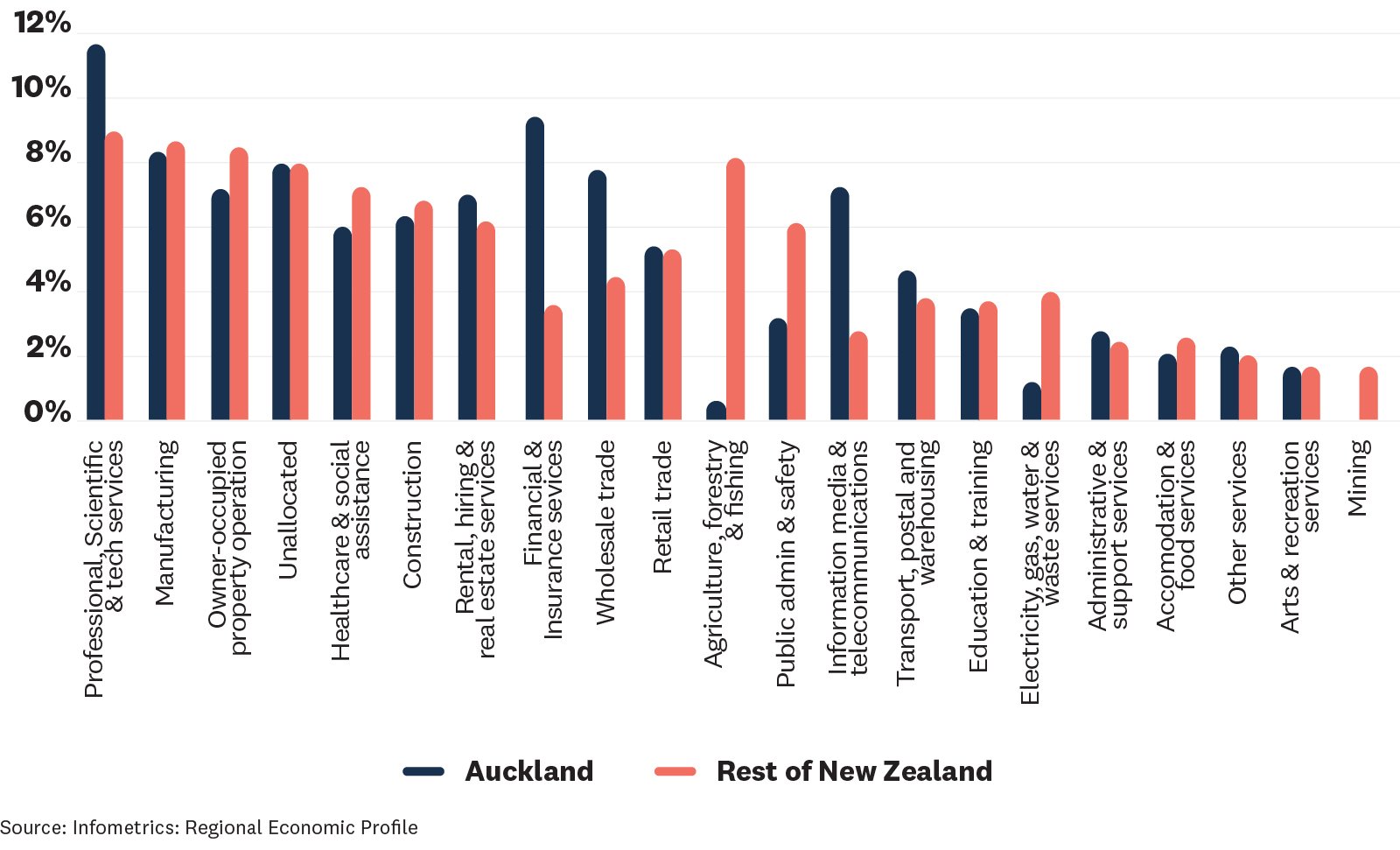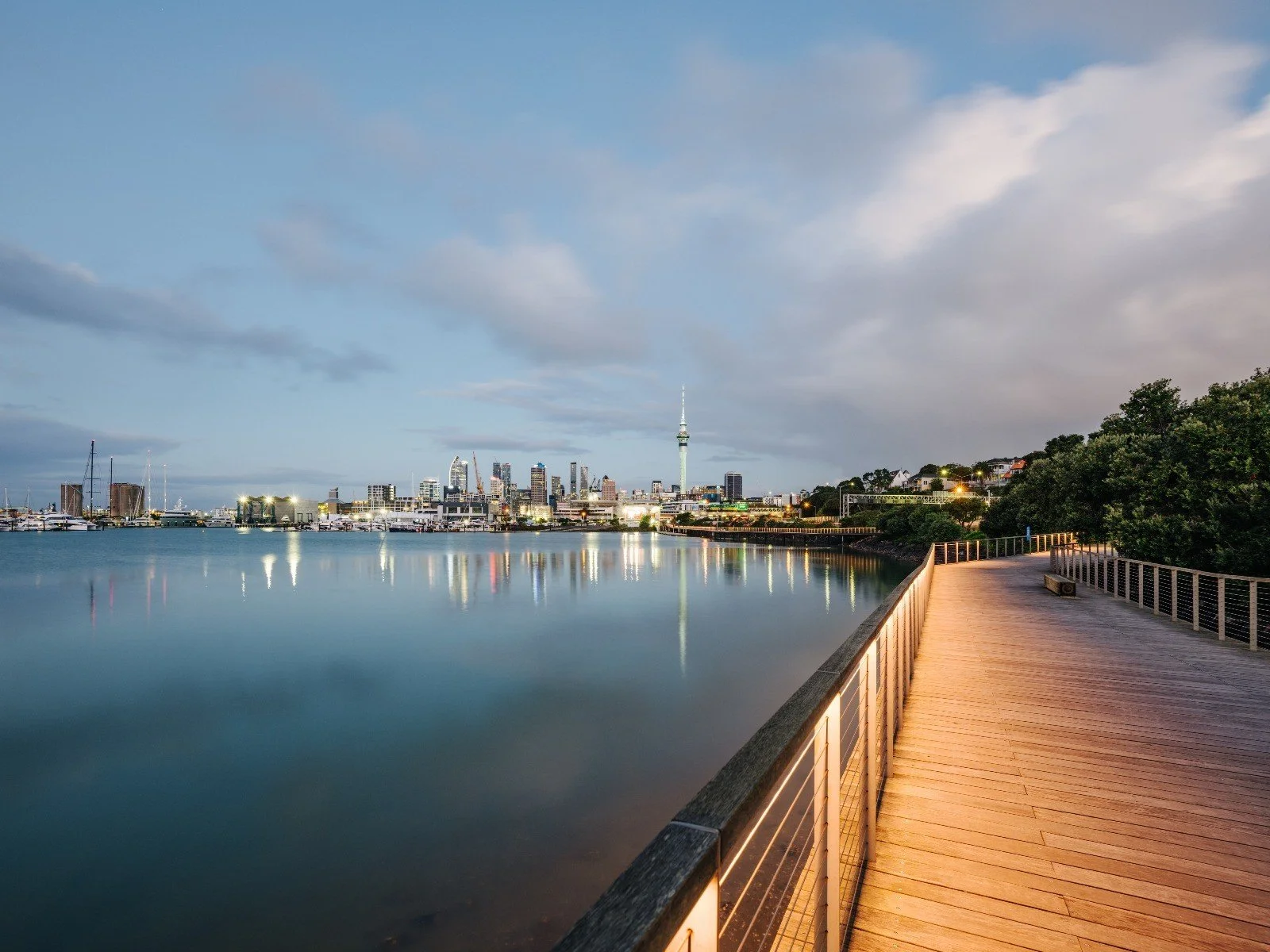
Economic activity
Auckland's GDP
GDP (March year, 2024 Prices, $bn)
Real GDP growth rate (March year)
Tāmaki Makaurau Auckland is the powerhouse of the Aotearoa New Zealand economy. With 33% of the population, it generates 38% of the country’s GDP – $143bn in the year to March 2023.
Auckland contributes a significant amount of New Zealand’s GDP – much more than any other region, and much more than its population-based share.
Apart from a small blip in the year to March 2021, GDP continued to grow during the COVID-19 period, despite the significant lockdowns and associated restrictions on economic activities. Auckland’s economy emerged from the COVID-19 period even larger than it was beforehand.
Auckland’s GDP has consistently grown faster than the rest of the country since the GFC. Given Auckland is projected to account for an even larger proportion of New Zealand’s workforce in the future, Auckland’s share of New Zealand’s GDP will likely continue to increase as well.
-
Auckland’s GDP in 2023 was $143bn.
This was 10% higher than the 2019 value of $130bn (in real terms), reflecting a compounding average annual real growth of 1.9% during that period.
GDP estimates from Infometrics for the year to March 2024 suggest a slowing down of economic activity over the last 12 months.
Auckland currently contributes 38% of New Zealand’s total GDP, significantly higher than Auckland’s share of the population (33%), and more than double the contribution of Wellington, the next largest region.
-
Auckland’s GDP is growing faster than the rest of New Zealand’s.
In 2023 Auckland’s GDP grew by 4.2% (in real terms), while the rest of New Zealand’s only grew by 2.1%.
Since the GFC, Auckland’s contribution to New Zealand’s GDP has increased from 34% to 38%, which is more than the increase in its share of the population.
Auckland’s GDP growth has consistently outpaced the rest of New Zealand’s over the last 20 years, including Wellington’s.
The exception to this was in 2009 and 2010 during the GFC, as well as in 2021 during the COVID-19 period.
Source: Stats NZ: Regional GDP – RNA. Infometrics: Regional Economic Profile
What’s driving GDP growth?
% share of GDP by industry (2024)
Real GDP growth rate by industry (2024)
Auckland’s economy is well-diversified – more than any other area of New Zealand – but it has a relative focus on high value service industries.
Auckland does not rely on any individual industry and its relative specialisation in high-value services1 helps drive its growth. These high value services have grown faster than other industries and contribute more to Auckland’s GDP than they did pre-COVID-19.
Auckland’s economic diversification can make the region’s economy more resilient to economic shocks, like COVID-19. At the same time, Auckland is especially reliant on international supply chains, with our transport, postal and warehousing industry experiencing the largest decline in GDP during the first year of the pandemic.
1. High-value services include knowledge intensive service industries. According to the Infometrics categorisation, knowledge intensive refers to services where “at least 25% of the workforce must be qualified to degree level, and at least 30% of the workforce must be employed in professional, managerial, scientific, and technical occupations”
-
Auckland’s largest industries by GDP (ANZSIC Level 1) are ‘professional, scientific and technical services’, and ‘financial and insurance services’, contributing a combined $29bn in GDP in the year to March 2023.
Industries providing high-value services accounted for 32% of Auckland’s GDP in the year to March 2023, compared to 24% for the rest of New Zealand.
Primary industries contribute very little to Auckland’s economy (0.3% of GDP), compared to the rest of New Zealand (9%).
Auckland’s economy is well diversified. The largest industry (‘professional, scientific and technical services’) contributes 11% of Auckland’s GDP. Across the other 66 territorial authorities, the average GDP contribution for the largest industries is 20%.
-
The three industries which grew the most between 2019 and 2023 are all high-value services industries, namely ‘information media and telecommunications’ (25%), ‘professional, scientific and technical services’ (24%), and ‘healthcare and social assistance’ (17%).
These industries may have been less impacted by COVID-19 than ‘blue collar’ industries, but they were growing relatively fast before COVID-19 as well.
Construction was the fastest growing industry in the years before COVID-19, but similar growth has not been evident more recently. That reflects its cyclical nature, with current forecasts suggesting a further decline in real GDP terms over the next few years.
While most Auckland industries have increased their GDP (in real terms) since 2019, some have not:
‘Manufacturing’, ‘transport, postal and warehousing’, ‘education and training’ and ‘agriculture, forestry and fishing’ have all declined (in real terms) since 2019.
Source: Infometrics: Regional Economic Profile
Real GDP per capita
Real GDP per capita (March year, 2024 Prices)
Auckland’s economy generates GDP per capita of $82,000. Despite a blip during COVID-19, real GDP per capita has grown over time, albeit slower than GDP overall.
When spread over Auckland’s population, the $143bn GDP generated in the year to March 2023 represents $82,000 per person. Real GDP per capita has continued to grow over time, meaning our overall standard of living is improving, at least on average. While this means that labour productivity is increasing, population growth far outpaced GDP growth prior to COVID.
Apart from a small blip in 2021, real GDP per capita grew again in the years to March 2022 and 2023. However, with an estimated slowdown in economic growth and a significant increase in the population driven by migration, it is likely that GDP per capita has declined again over the last 12 months.
-
Auckland’s GDP per capita in the year to March 2023 ($82,000) was 18% higher than the GDP per capita value for the rest of New Zealand ($67,000).
Wellington’s GDP per capita ($91,000) is 11% higher than Auckland’s. It is the only New Zealand region with a higher GDP per capita than Auckland, which reflects its even greater focus on high value services and central government administration.
Real GDP per capita in Auckland grew by 1.4% in the year to March 2023.
This is faster than the rest of New Zealand (0.2%).
Relative to 2019, Auckland’s real GDP per capita was 6.4% higher in 2023. However, GDP estimates from Infometrics suggest a slowing down of economic activity in Auckland in the year to March 2024 (+0.5%), with GDP per capita likely declining as a result.
Sources: Real GDP growth, real GDP per capita, inputs for Auckland GDP index – Infometrics: Regional Economic Profile
Auckland Economic Monitor
A summary of key economic information about the region
Auckland’s economy: What’s changed?
Deep dives
Cost of living
Inflation reached levels not seen since the 80s in 2022 and remains above historical levels.
Investment & trade
Auckland plays a significant role in the country’s investment and trade landscape.
Auckland’s industrial employment areas
Trends over the last two decades.















